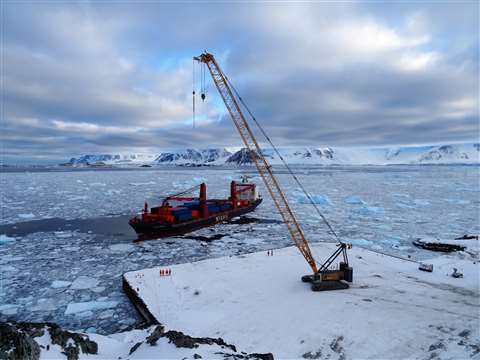New Antarctic Wharf hits construction milestone
20 April 2020
For the first time, polar ships have moored at a new £40 million (US$49 million) wharf at British Antarctic Survey’s (BAS) Rothera Research Station in Antarctica.

The RRS James Clark Ross used it to re-supply the station and pick up staff for return to the UK. Construction partners and designers of the Wharf, BAM, with the support of Sweco and technical advisors, Ramboll, completed a second, six-month construction season, during the Antarctic austral summer.
The new wharf, which replaces a smaller structure built in the 1980s, is part of the Antarctic Infrastructure Modernisation Programme.
The 74m wharf is designed to accommodate the new polar research vessel, RRS Sir David Attenborough. With its enhanced cargo handling facilities, including a larger crane, the new wharf will enable more efficient loading and unloading of supplies, as well as the deployment of small boats used for scientific diving and marine research.
Building in one of the world’s most extreme environments required careful planning, digital construction expertise and the ability to work collectively at every stage of the process.
Operating safely and sustainably helped overcome potential risks from adverse weather, icebergs and wildlife, such as whales and seals. On site team integration and suitable wellbeing support were essential ingredients for working life, particularly for those who were new to working in the Antarctic.
Maintaining the highest standards of biosecurity and demonstrating that the operation has no lasting negative impact on the natural environment and ongoing science operations, was vital in the construction of the wharf. All site team members received environmental and biosecurity training before deploying.

The 45-tonne steel frames forming the skeleton were tested to identify any unexpected challenges or additional pieces of equipment that may be needed whilst still in the UK – critical before shipping materials 11,000km to Rothera.
The second season of construction began last November with de-winterising the site; clearing 2,000 tonnes of snow at the start of the Antarctic summer. The team successfully installed the final 14 huge frames and all the facing sheet piles, equating to over 1000 tonnes of steel. The wharf was then backfilled to complete the structure.
Bruce Wulff, project manager at Ramboll said, “Designing a wharf in the Antarctic, on a steeply sloping rock seabed, with massive icebergs floating past, and Orcas and penguins as your neighbours, has presented its challenges! Four years later, to see this beautiful piece of engineering completed is very moving.”
While the wharf equipment will be formally commissioned and accepted later this year, the wharf’s completion has allowed it to be used to demobilise this year’s building programme early in response to COVID-19 precautionary measures.




